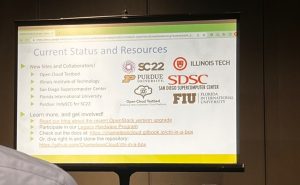Overall Experience at PearC22 Conference:

RAPTOR project and how advanced research computing is evolving with new technology. I attended the conference under the student program; this program allowed me to network with like-minded individuals. The program had workshops curated to fine-tune one’s elevator pitch, a resume clinic, speed interviews, and even assigned every individual a mentor depending on one’s interest. During the week, students could volunteer in different workshops that would assist during presentations or potentially assist individuals attending the conferences. The student sessions allowed students in the same position as me to share their experiences – whether working at a particular company or doing an internship. These students shared how their trajectories were altered after experiencing what it was like to work in these companies and positions. I often found myself sharing my limited experience in the field and the project we were working on back home. Many students said that they were once in my shoes and let me know that every minute is a learning experience as there is always something to learn from someone. During breaks, companies were looking to promote their up-and-coming technologies relating to advanced computing, internship opportunities, or cloud computing technologies. I often found myself making my way to the tables to discuss the potential of advanced computing relevant to their companies or new internship opportunities that these individuals deemed fitting from my resume. Although the different sessions provided by the student program helped present me professionally, networking with these individuals at their tables was an amazing experience. I understood the values of the company they worked for and whether it was an experience they enjoyed. After discussing a few things about the field, I often asked them what they recommend for students like me to study. I got various answers, but all stemmed back to the idea of doing whatever you enjoy and finding your niche in this community.
Related experience to RAPTOR:
When planning for the week, I saw two presentations relating to RAPTOR; the presentations covered different aspects of Chameleon and the usage of the Open Science Grid.
The Chameleon presentation allowed me to understand their program’s application and how Chi-in-a-Box reduces operation costs in Research Testbeds. Chameleon was described as an adaptable testbed that will alter depending on the team’s research needs; they promoted the diversity and scale of their research abilities – being able to help from the smallest research needs to the biggest needs. In relation to RAPTOR, I got a deeper understanding of how Chi-in-a-Box worked and how it challenged competitors by being the answer to the adversities faced in scaling a test bed. The presentation also discussed different partnerships one can have with Chameleon and all the benefits they provide when using their software in monitoring, detection, and remediation. Professors and Directors shared their experiences and gave me insight into what I can expect when implementing the software. Some professors even discussed some of the problems faced when attempting to use the testbed.
The Open Science Grid presentation promoted the deployment of a secure Kubernetes environment and additional features that further strengthened the software. The environment is deployed but still incomplete; the presentation shared a list of future work that one should expect, ranging from kyverno policy completeness, altering databases, and balancing incoming loads. OSG shared the deployment of the environment and discussed how they would be hosting sessions to assist with general-purpose usage.

